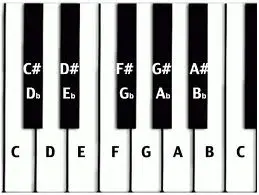The chromatic scale is the easiest scale to learn and play. Why is that? Well, this scale is completely made up of half steps that move in consecutive order.
On the piano, that means you start on one key and play every single key after that…in order. This includes both white keys and black keys.
The Chromatic Scale Rules
1. Movement from one note to the next is by consecutive half steps.
You will never find a whole step in this scale. Think of it this way, the next note you move to is the next possible note/key you can play.
2. The scale may begin on any note.
It does not matter what note you start on. Since this scale moves only by half steps, you can start anywhere!
3. The key signature does not make a difference since the scale is made up of half steps.
For once, you don’t have to think about the key signature! All you need to remember is to move by half steps or the next possible note you can play.
4. In a one-octave chromatic scale, there are 12 different tones.
How is this different from other scales? All the other one-octave scales have a total of 8 tones with the first and last note being the same.
The chromatic scale has a total of 12 different notes. If you repeat the first note at the end of the scale, then there are 13 notes total.
Example of a Chromatic Scale
1. When the scale goes up, it is called ascending. An ascending chromatic scale uses sharp signs.
Ascending: C-C#-D-D#-E-E#/F-F#-G-G#-A-A#-B-B#/C
 2. When the scale goes down, it is called descending. A descending chromatic scale uses flat signs.
2. When the scale goes down, it is called descending. A descending chromatic scale uses flat signs.
Descending: C-B-Bb-A-Ab-G-Gb-F-E-Eb-D-Db-C
Here is how it looks on the piano keys. Remember that you read sharps going up and flats going down.
Moving to the right on the piano is ascending (pitch getting higher) and moving to the left is descending (pitch getting lower).
Chromatic Scale Chart
C-C#/Db-D-D#/Eb-E-F-F#/Gb-G-G#/Ab-A-A#/Bb-B-C
C#/Db-D-D#/Eb-E-F-F#/Gb-G-G#/Ab-A-A#/Bb-B-C-C#/Db
D-D#/Eb-E-F-F#/Gb-G-G#/Ab-A-A#/Bb-B-C-C#/Db-D
D#/Eb-E-F-F#/Gb-G-G#/Ab-A-A#/Bb-B-C-C#/Db-D-D#/Eb
E-F-F#/Gb-G-G#/AB-A-A#/Bb-B-C-C#/Db-D-D#/Eb-E
F-F#/Gb-G-G#/Ab-A-A#/Bb-B-C-C#/Db-D-D#/Eb-E-F
F#/Gb-G-G#/Ab-A-A#/Bb-B-C-C#/Db-D-D#/Eb-E-F-F#/Gb
G-G#/Ab-A-A#/Bb-B-C-C#/Db-D-D#/Eb-E-F-F#/Gb-G
G#/Ab-A-A#/Bb-B-C-C#/Db-D-D#/Eb-E-F-F#/Gb-G-G#/Ab
A-A#/Bb-B-C-C#/Db-D-D#/Eb-E-F-F#/Gb-G-G#/Ab-A
A#/Bb-B-C-C#/Db-D-D#/Eb-E-F-F#/Gb-G-G#/Ab-A-A#/Bb
B-C-C#/Db-D-D#/Eb-E-F-F#/Gb-G-G#/Ab-A-A#/Bb-B
C-C#/Db-D-D#/Eb-E-F-F#/Gb-G-G#/Ab-A-A#/Bb-B-C
Do you see how the chromatic scale can start on any note? Also, notice how you can see the chromatic scale vertically (up & down) in this chart, as well as, horizontally (left to right).
That’s what happens when a scale is created by half steps. All kinds of cool patterns begin to emerge!
Do All Instruments Play this Scale?
Yep, every instrument will use the chromatic scale as part of your foundational learning and technique. This scale is found in a lot of music passages. It is very helpful to know how to play it before you run into situations where you need to read and play it in your music.
With this little bit of knowledge, you will be able to identify a chromatic scale when you see one in your music and play it without having to read every single note. This is especially true if you have the scale memorized in your fingers!
Just look at the first note, the top note (know where you are going), and play every half step in consecutive order in between, starting on the beginning note until you reach the top note. Pretty easy!
Things to Remember…
The chromatic scale is made up of half steps. We read sharps when the scale is ascending and flats when the scale descends. This scale can begin on any note with the key signature not making a difference on how we treat the scale.
In a one-octave chromatic scale, there are 12 tones total….13 if you repeat the first note. This scale is the easiest one to play because all you have to do is play the next possible notes in consecutive order.
Practice
Practice reading and playing the chromatic scale starting on the same note every time. Make it part of your daily regimen until it is memorized.
Then, start on a different note and do the same thing. Keep doing this until you feel you can play the chromatic scale memorized using the entire range of your instrument up and down.
Print out the chromatic scale chart above and keep it with your practice materials. It can be a helpful reference tool.
If you have learned the chromatic scale successfully, you should be able to play it starting on any note without any problem.
Keep up your learning and practicing! You are on your way to becoming a successful musician!


